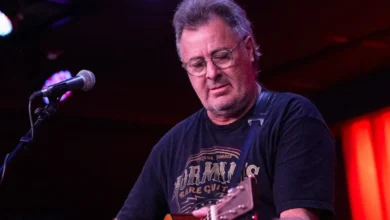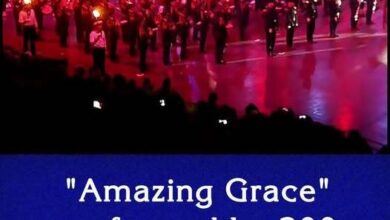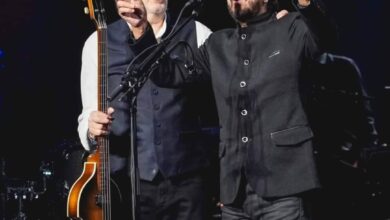This Popular Dance From The 1950s, Do You Remember It Today
In February 1958, the American high school landscape underwent a vibrant transformation as a new dance craze ignited enthusiasm in gymnasiums and sock hops alike. This dance, known to many as “The Stroll,” epitomized the spirited essence of rock ‘n’ roll’s early days, emerging as a joyful expression of youth culture. It reflected the carefree, exuberant energy of a generation that was eager to celebrate its newfound autonomy and identity against the backdrop of a swiftly changing social landscape. Though its roots lay in the African American community, “The Stroll” swiftly ascended to prominence, largely propelled by its visibility on American television, particularly through the popular music show “American Bandstand,” hosted by Dick Clark. This program played a pivotal role in showcasing the latest dance trends to a national audience, allowing diverse teenagers across the country to engage with the spirited movements of the time.
“The Stroll” distinguished itself not merely as another dance; it transformed into a cultural touchstone that mirrored the social dynamics of 1950s America. The format of the dance was deceptively simple: participants formed two lines facing one another, creating an aisle in which couples could strut their stuff. The ease of participation invited widespread involvement, as it allowed individuals to showcase their unique styles while still being part of a collective experience. This communal aspect resonated deeply with teenagers who sought to navigate their identities amidst a backdrop of societal changes. As young people began to assert themselves and challenge traditional norms, “The Stroll” offered a platform to express their individuality in a joyful and carefree manner.
At the heart of the dance’s contagious energy was the iconic song “The Stroll,” performed by the Canadian vocal group The Diamonds. Known for their smooth harmonies and catchy doo-wop melodies, The Diamonds played an instrumental role in propelling the dance into the national consciousness. Their rendition of “The Stroll” quickly became an anthem that encapsulated the joy and rebellious spirit of the era. The lead singer, Dave Somerville, famed for his rich baritone, became the voice that guided dancers as they grooved to the upbeat tempo, allowing his melodic crooning to resonate with listeners and participants alike. The song’s infectious rhythm was an invitation for teens to get up and dance, fostering an environment where the excitement of youth culture could flourish.
The rise of “The Stroll” was not confined to dance floors; it became a defining characteristic of social events across America. The dance’s appeal crossed cultural and racial boundaries during a time when segregation remained a significant issue in the United States. The Stroll’s simplicity was its strength—anyone could participate, regardless of dance ability. The joy it brought was irresistible and allowed a sense of unity to emerge in a segregated society. Teenagers dressed in their finest clothing eagerly took to the dance floor, eager to participate in this latest trend that invited a display of confidence and communal joy, mirroring the upbeat optimism of post-war America.
As the craze continued to grow, “The Stroll” symbolized the deep-seated desire of a generation to express themselves and savor the freedoms of the 1950s. Its presence on popular television shows and in mainstream music solidified its status as a memorable part of American pop culture. The dance was more than just a fleeting trend; it became intertwined with the essence of the era, a testament to the power of music and movement to bring people together. Its legacy endures, reminding us of a time when youthful exuberance and cultural shifts converged in a celebration of life, connection, and joyful expression.
Aside from their hit song, The Diamonds, with members including Somerville, Phil Levitt, and others, were known for their harmonies and performances. The group formed in 1953 and saw various lineups throughout their career, but their unique sound consistently resonated with audiences. They achieved several hits throughout the late 1950s, including iconic tracks that contributed to the doo-wop genre’s popularity. Their ability to blend catchy melodies with heartfelt lyrics placed them as fixtures in the music scene of the time.
Though “The Stroll” would eventually fade as new dances emerged and changing tastes in music continued to evolve, its influence on the cultural landscape remains undeniable. The dance served not only as a source of entertainment but also as a means of liberation for many young people. The ability to gather with friends, celebrate life, and express individuality through movement became a cherished memory for countless individuals. As teenagers forged their own identities, they embodied a spirit that would influence many future generations.
In many ways, “The Stroll” laid the groundwork for subsequent dance crazes, showcasing the vital role that music and dance play in youth culture. It provided a communal space where teenagers could come together, transcending social barriers, and celebrating their shared experiences. The popularity of participatory dances became central to how youth cultures would define themselves, influencing everything from music videos to dance contests in later decades.
Ultimately, “The Stroll” stands as a representative marker of the 1950s—a decade characterized by shifts in social norms, burgeoning youth culture, and a quest for self-expression. While much of the surface meaning of “The Stroll” lay in its catchy tune and enjoyable steps, its deeper significance resides in its portrayal of an entire generation navigating a new landscape of freedom and identity. It remains etched in the memories of those who danced to its beat, capturing a moment in history that celebrates the enduring power of music, dance, and youthful spirit.
?si=CbHsPwTM-VodZAIG





